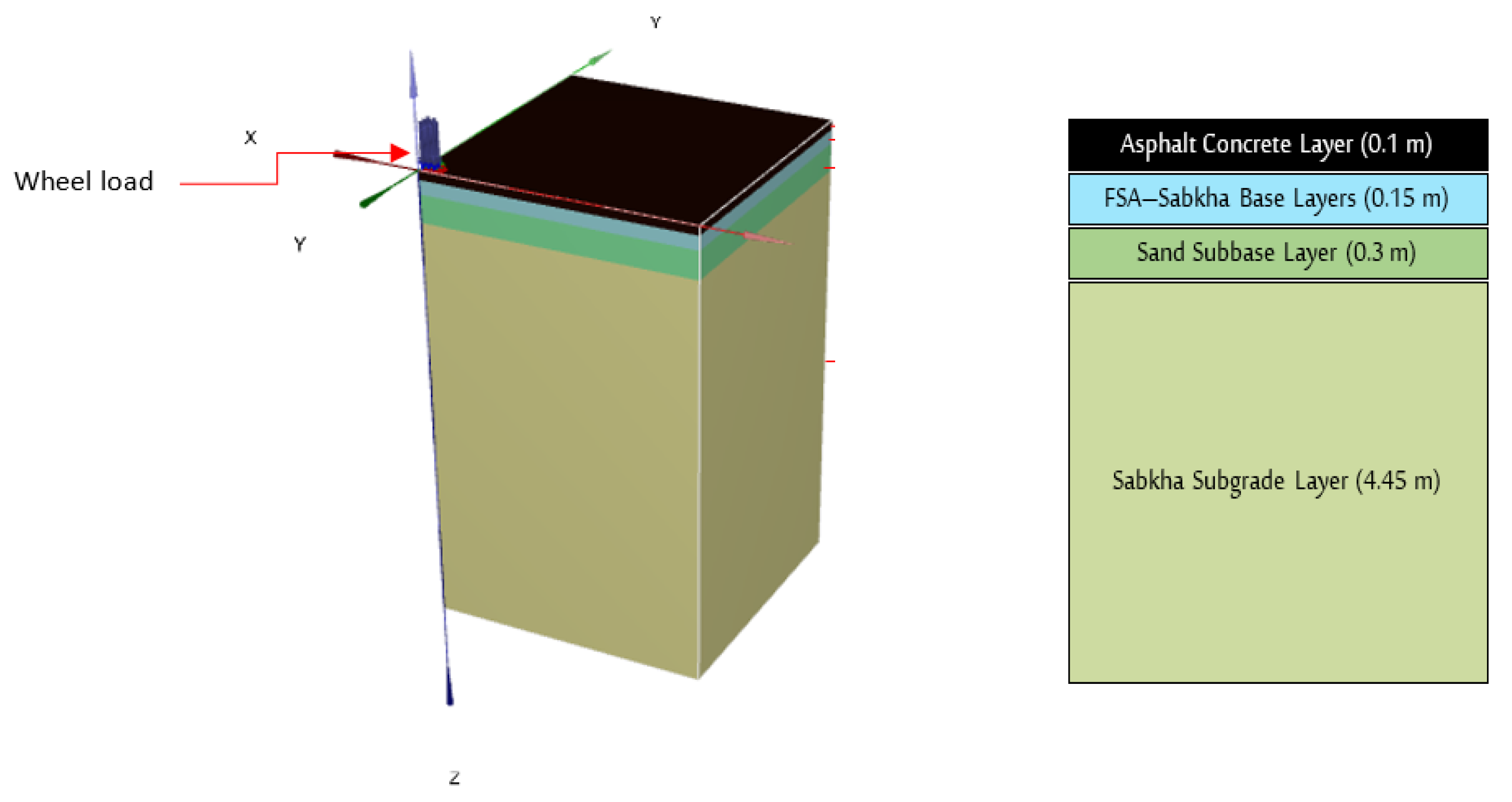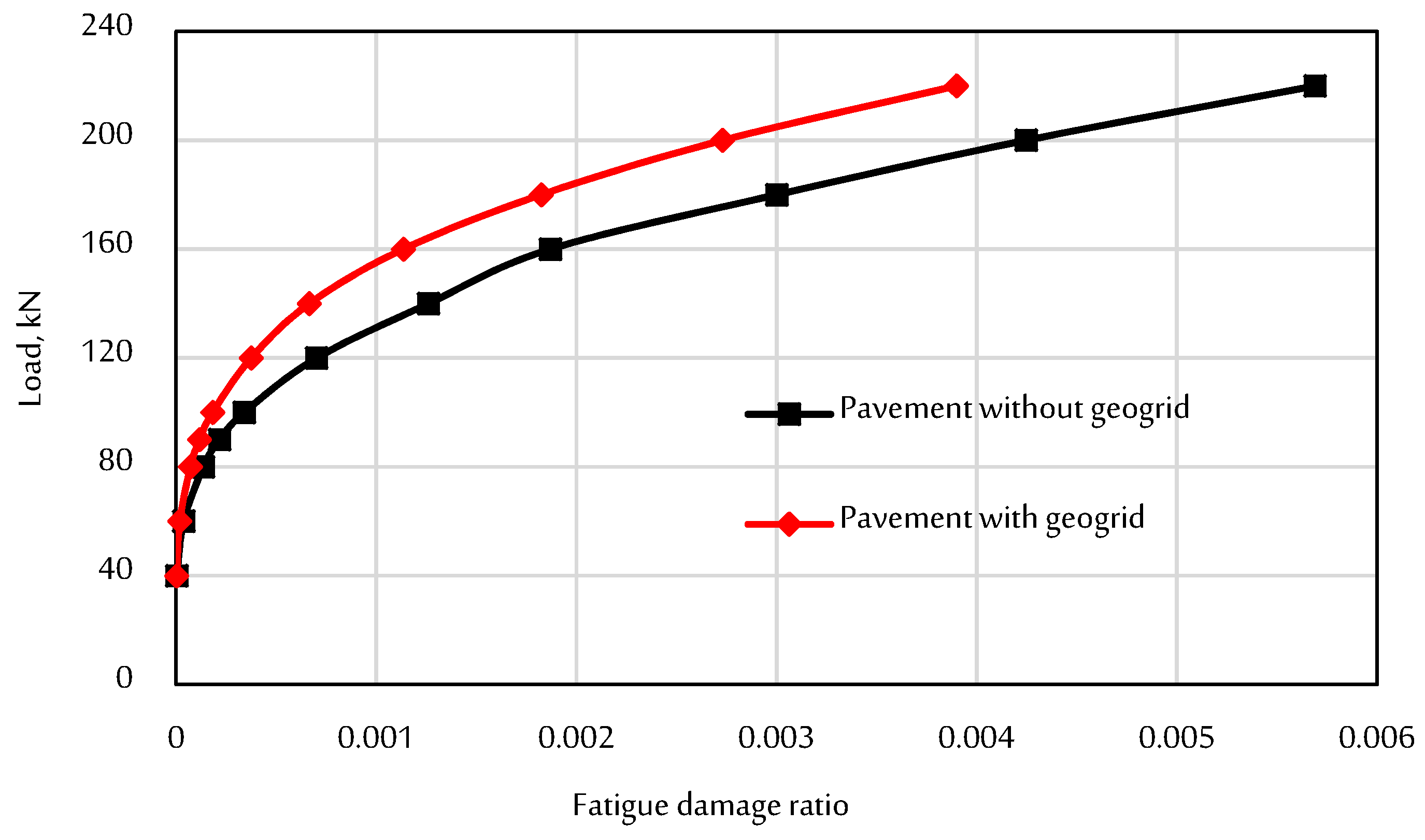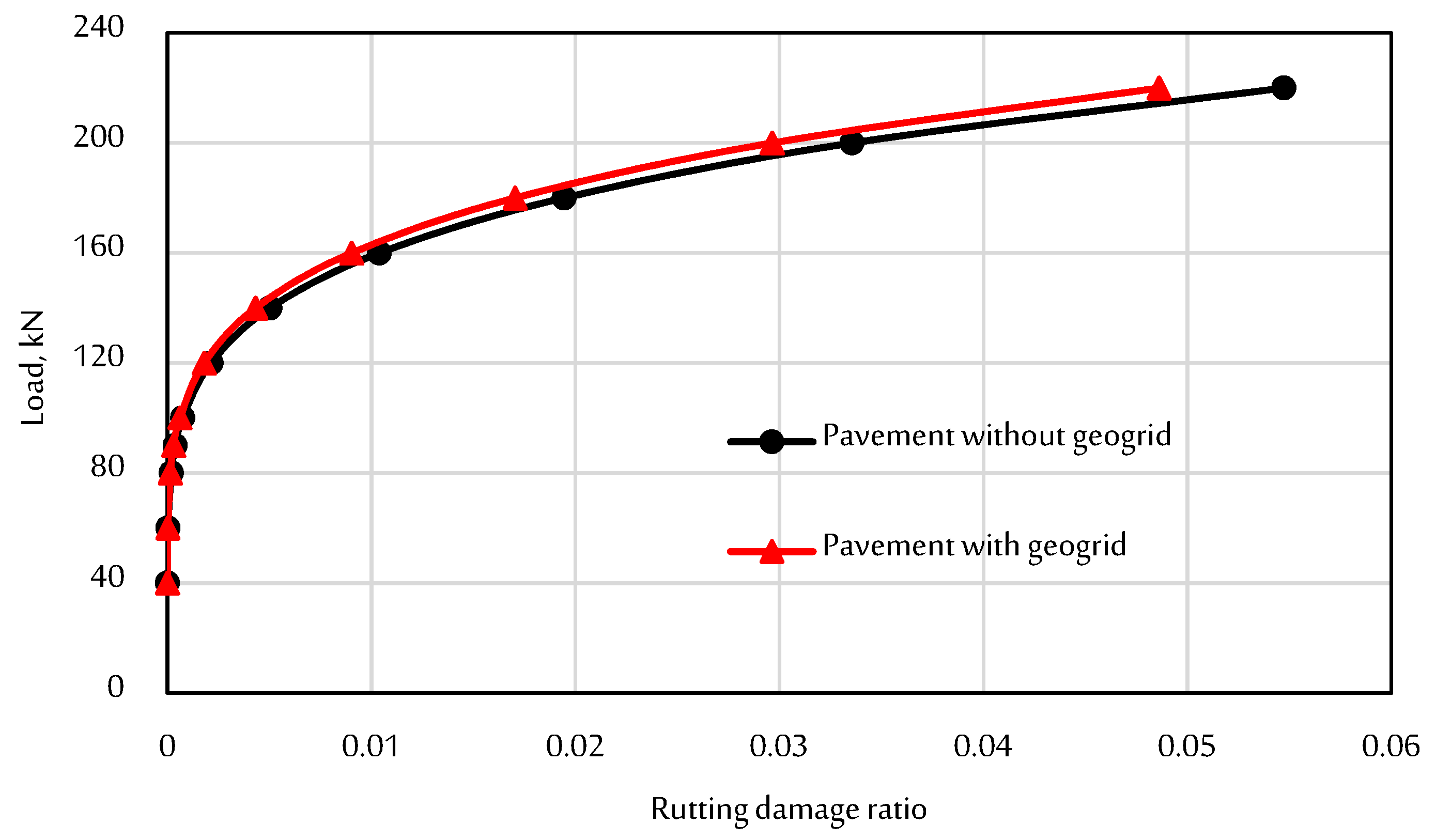Performance of Enhanced Problematic Soils in Roads Pavement Structure: Numerical Simulation and Laboratory Study
Abstract
:1. Introduction
2. Finite Element Modeling
2.1. Constitutive Models and Materials Parameters
2.2. Loading, Boundary Conditions, and Meshing
3. Results and Discussion
4. Impact of Geogrid Reinforcement on Fatigue and Rutting Life Intervals
5. Comparing Plaxis 3D Outcomes with Laboratory Test Results
6. Conclusions
- When the geogrid was positioned at the Sabkha subgrade layer, it led to the maximum reduction in horizontal tensile strains, up to 32.71%. Thus, geogrid reinforcement showed good potential for decreasing fatigue strains in the pavement structure.
- No significant differences in the vertical strains were found between reinforced and geogrid-reinforced pavements. The highest reduction was about 13.2%. Similarly, the maximum reduction for vertical displacement was about 14.2%.
- Geogrid reinforcement decreased the fatigue damage ratio significantly (33% to 55%), while the reduction in rutting damage ratio was a little bit lower (14% to 30%). However, its effect in reducing vertical displacement was marginal.
- Positioning a geogrid on the subgrade leads to a higher reduction in fatigue, rutting strains, and vertical displacement.
- Geogrid reinforcement enhanced the performance of the pavement structures consisting of stabilized Sabkha with a foamed sulfur asphalt base layer, which was resting at the marginal problematic Sabkha subgrade and was usable for low-to-moderate traffic volume roads.
- The use of FE simulations with the Plaxis 3D software is a powerful and reliable tool for predicting the performance of Sabkha soil in pavement structure materials under traffic loading, as evidenced by extremely satisfactory results when compared to laboratory experimental tests.
Funding
Institutional Review Board Statement
Informed Consent Statement
Data Availability Statement
Acknowledgments
Conflicts of Interest
References
- Akili, W. Salt encrusted desert flats (sabkha): Problems, challenges and potential solutions. In Unsaturated Soils 2006; American Society of Civil Engineers: Reston, VA, USA, 2006; pp. 391–402. [Google Scholar] [CrossRef]
- Abdullah, G.M.; Wahhab, H.I.A.-A.J.C.; Materials, B. Evaluation of foamed sulfur asphalt stabilized soils for road applications. Constr. Build. Mater. 2015, 88, 149–158. [Google Scholar] [CrossRef]
- Al-Homidy, A.A.; Dahim, M.H.; El Aal, A.K.A. Improvement of geotechnical properties of sabkha soil utilizing cement kiln dust. J. Rock Mech. Geotech. Eng. 2017, 9, 749–760. [Google Scholar] [CrossRef]
- Abdullah, G.M.; Al-Abdul Wahhab, H.I.J.R.M.; Design, P. Stabilisation of soils with emulsified sulphur asphalt for road applications. J. Rock Mech. Geotech. Eng. 2019, 20, 1228–1242. [Google Scholar] [CrossRef]
- Abdullah, G.M.S. Modeling the Behavior of Sulfur Modified Foamed and Emulsified Asphalt Soils Mixes for Local Road Applications. Ph.D. Thesis, King Fahd University of Petroleum and Minerals, Dhahran, Saudi Arabia, 2014. [Google Scholar]
- Abdullah, G.M.; El Aal, A.A. Assessment of the reuse of COVID-19 healthy personal protective materials in enhancing geotechnical properties of Najran’s soil for road construction: Numerical and experimental study. J. Clean Prod. 2021, 320, 128772. [Google Scholar] [CrossRef]
- Al-Amoudi, O.S.B.; Abduljauwad, S.N.; El-Naggar, Z.R.J.E.G. Response of sabkha to laboratory tests: A case study. Eng. Geol. 1992, 33, 111–125. [Google Scholar] [CrossRef]
- Abduljauwad, S.; Al-Amoudi, O.J.G. Geotechnical behaviour of saline sabkha soils. Geotechnique 1995, 45, 425–445. [Google Scholar] [CrossRef]
- Asi, I.; Siddiqui, Z.; Al-Abdul Wahhab, H.; Khan, M. Stabilization of sabkha soil for road bases using foamed asphalt technology. In Proceedings of the Fifth Saudi Engineering Conference, Makkah, Saudi Arabia, 1–4 March 1999. [Google Scholar]
- Asi, I.M.; Wahhab, H.A.-A.; Al-Amoudi, O.B.; Khan, M.I.; Siddiqi, Z. Stabilization of dune sand using foamed asphalt. Geotech. Test. J. 2002, 25, 168–176. [Google Scholar]
- Abdullah, G.M.J.G.; Engineering, G. Pavement thickness design charts derived from rut depth models developed for foamed and emulsified sulfur asphalt soil mixes. Geotech. Geol. Eng. 2020, 38, 3053–3065. [Google Scholar] [CrossRef]
- Kazmi, Z.A. Application of date palm ash to improve strength characteristics of sabkha soil. IOP Conf. Ser. Mater. Sci. Eng. 2020, 958, 012007. [Google Scholar] [CrossRef]
- Raja, M.N.A.; Shukla, S.K. Predicting the settlement of geosynthetic-reinforced soil foundations using evolutionary artificial intelligence technique. Geotext. Geomembr. 2021, 49, 1280–1293. [Google Scholar] [CrossRef]
- Alharbi, F.; Almoshaigeh, A.; Almoshaogeh, M.; Elragi, A.; Elkholy, S.J.E. Effect of Geo-Grid Depth in Roads Cross-Section on Reducing Pavement Rutting. Eng 2022, 3, 1–8. [Google Scholar] [CrossRef]
- Krishna, U.S.R.; Ch, N.S.K. Analytical modelling of ultra-thin white topping cement concrete overlay on bituminous concrete pavement using ANSYS. World J. Eng. 2022; ahead-of-print. [Google Scholar] [CrossRef]
- Abdullah, G.M. 3D finite element modeling to predict the foamed sulfur asphalt marl soil mixes rutting behavior. Ain Shams Eng. J. 2019, 10, 661–668. [Google Scholar] [CrossRef]
- Peng, J.; Zhang, J.; Li, J.; Yao, Y.; Zhang, A. Modeling humidity and stress-dependent subgrade soils in flexible pavements. Comput. Geotech. 2020, 120, 103413. [Google Scholar] [CrossRef]
- Mousavi, S.H.; Gabr, M.A.; Borden, R.H. Optimum location of geogrid reinforcement in unpaved road. Can. Geotech. J. 2017, 54, 1047–1054. [Google Scholar] [CrossRef]
- Abdullah, G.M. Using Plaxis 2D finite element modeling to assess bearing capacity of Sultana’s soil in Najran Region, Kingdom of Saudi Arabia. Mater. Today Proc. 2022, 49, 2679–2687. [Google Scholar] [CrossRef]
- Djellali, A.; Sarker, D.; Saghafi, B. Experimental and numerical prediction of airport pavement over expansive subgrade stabilized by asphalt layers. Arab. J. Geosci. 2022, 15, 1503. [Google Scholar] [CrossRef]
- Mudiyono, R. Evaluating the Road Construction Feasibility Performance of the Rigid Pavement in the Flood-Prone Area: A Case Study of Indonesia. IOP Conf. Ser. Earth Environ. Sci. 2022, 971, 012007. [Google Scholar] [CrossRef]
- Berg, R.R.; Christopher, B.R.; Perkins, S. Geosynthetic reinforcement of the aggregate base course of flexible pavement structures. In Geosynthetic Materials Association; Ryan R. Berg & Associates, Inc.: Roseville, MN, USA, 2000; Volume 130. [Google Scholar]
- Perkins, S.W. Mechanistic-Empirical Modeling and Design Model Development for Geosynthetic Reinforced Flexible Pavements; Montana. Dept. of Transportation, Research Section: Helena, Montana, 2001. [Google Scholar] [CrossRef]
- Perkins, S. Evaluation of Geosynthetic Reinforced Flexible Pavement Systems Using Two Pavement Test Facilities; Federal Highway Administration: Washington, DC, USA, 2002. [Google Scholar] [CrossRef]
- Howard, I.L.; Warren, K.A. Finite-element modeling of instrumented flexible pavements under stationary transient loading. J. Transp. Eng. 2009, 135, 53–61. [Google Scholar] [CrossRef]
- Wathugala, G.W.; Huang, B.; Pal, S. Numerical simulation of geosynthetic-reinforced flexible pavements. Transp. Res. Rec. J. Transp. Res. Board 1996, 1534, 58–65. [Google Scholar] [CrossRef]
- Valašková, V.; Vlček, J.; Papán, D. Determination of the Small-Scale Physical Model Parameters of Pavement Structure. Sustainability 2020, 12, 9637. [Google Scholar] [CrossRef]
- Ling, J.; Wei, F.; Zhao, H.; Tian, Y.; Han, B.J.C.; Materials, B. Analysis of airfield composite pavement responses using full-scale accelerated pavement testing and finite element method. Constr. Build. Mater. 2019, 212, 596–606. [Google Scholar] [CrossRef]
- Liu, Z.; Gu, X.; Ren, H.; Zhou, Z.; Wang, X.; Tang, S. Analysis of the dynamic responses of asphalt pavement based on full-scale accelerated testing and finite element simulation. Constr. Build. Mater. 2022, 325, 126429. [Google Scholar] [CrossRef]
- Liu, Z.; Gu, X.; Ren, H.; Wang, X.; Dong, Q. Three-dimensional finite element analysis for structural parameters of asphalt pavement: A combined laboratory and field accelerated testing approach. Case Stud. Constr. Mater. 2022, 17, e01221. [Google Scholar] [CrossRef]
- Ling, H.I.; Liu, H. Finite element studies of asphalt concrete pavement reinforced with geogrid. J. Eng. Mech. 2003, 129, 801–811. [Google Scholar] [CrossRef]
- Sukumaran, B.; Willis, M.; Chamala, N. Three dimensional finite element modeling of flexible pavements. In Advances in Pavement Engineering; American Society of Civil Engineers: Reston, VA, USA, 2005; pp. 1–12. [Google Scholar] [CrossRef]
- Al-Azzawi, A.A. Finite element analysis of flexible pavements strengthed with geogrid. ARPN J. Eng. Appl. Sci. 2012, 7, 1295–1299. [Google Scholar]
- Pandey, S.; Rao, K.; Tiwari, D. Effect of geogrid reinforcement on critical responses of bituminous pavements. In Proceedings of the ARRB Conference, 25th, 2012, Perth, Western Australia, Australia, 23–26 September 2012. [Google Scholar]
- Sinha, A.K.; Chandra, S.; Kumar, P. Finite element analysis of flexible pavement with different subbase materials. Indian Highw. 2014, 42, 57–66. [Google Scholar]
- Tapase, A.B.; Ranadive, M. Performance evaluation of flexible pavement using the finite element method. In Geo-China 2016; American Society of Civil Engineers: Reston, VA, USA, 2016; pp. 9–17. [Google Scholar] [CrossRef]
- Al-Mehthel, M.; Al-Idi, S.H.; Wahhab, H.I.A.-A.; Hussein, I.A. Foamed Sulfur Asphalts for Pavement Recycling and Soil Stabilization. U.S. Patent 9,346,956, 24 May 2016. [Google Scholar]
- Moayedi, H.; Kazemian, S.; Prasad, A.; Huat, B.B.K. Effect of geogrid reinforcement location in paved road improvement. EJGE 2009, 14, 1–11. [Google Scholar]
- Sina, K.; Maassoumeh, B.; Arun, P.; Hossein, M.; Bujang, B.H.K. Reinforced pavement above trench under urban traffic load: Case study and finite element (FE) analysis. Sci. Res. Essays 2010, 5, 3313–3329. [Google Scholar]
- Alex, A. Characterization of Unbound Granular Layers in Flexible Pavements; Report No. ICAR/502-3; Texas Transportation Institute: Bryan, TX, USA, 2000. [Google Scholar]
- Brinkgreve, R.; Engin, E.; Swolfs, W. PLAXIS 3D 2020 User Manual; Plaxis bv: Delft, The Netherlands, 2020. [Google Scholar]
- Schanz, T.; Vermeer, P.; Bonnier, P.G. The hardening soil model: Formulation and verification. In Beyond 2000 in Computational Geotechnics; Routledge: Abingdon, UK, 2019; pp. 281–296. [Google Scholar] [CrossRef]
- Wu, K.; Ma, J.; Chuai, M.; Li, C.-H.; Chen, Y.; Lv, F. Numerical simulation of the near-fault spontaneous rupture and its influence on dynamic soil-structure interaction. Structures 2022, 38, 808–819. [Google Scholar] [CrossRef]
- Bolton, M.J.G. The strength and dilatancy of sands. Can. Geotech. J. 1986, 36, 65–78. [Google Scholar] [CrossRef]
- Mirmoradi, S.; Ehrlich, M. Modeling of the compaction-induced stress on reinforced soil walls. Geotext. Geomembr. 2015, 43, 82–88. [Google Scholar] [CrossRef]
- Ibrahim, E.; El-Badawy, S.; Ibrahim, M.; Gabr, A.; Azam, A. Effect of geogrid reinforcement on flexible pavements. Innov. Infrastruct. Solut. 2017, 2, 54. [Google Scholar] [CrossRef]
- Majedi, P.; Ghalehjough, B.K.; Akbulut, S.; Çelik, S. Effect of Reinforcement on stability and Settlement of Embankment: A finite element analysis of different kinds of reinforcing and construction conditions. Eur. J. Adv. Eng. Technol. 2017, 4, 759–764. [Google Scholar]
- Dondi, G. Three-dimensional finite element analysis of a reinforced paved road. In Proceedings of the fifth International Conference on Geotextiles, Geomembranes and Related Products, Singapore, 5–9 September 1994; pp. 95–100. [Google Scholar]
- Saad, B.; Mitri, H.; Poorooshasb, H. 3D FE analysis of flexible pavement with geosynthetic reinforcement. J. Transp. Eng. 2006, 132, 402–415. [Google Scholar] [CrossRef]
- Alkaissi, Z.A.; Al-Soud, M.S. Effect of Geogrid Reinforcement on Behavior of Unpaved Roads. IOP Conf. Ser. Earth Environ. Sci. 2021, 856, 012007. [Google Scholar] [CrossRef]
- Amena, S. Analysis of the Stability of Reinforced Plastic Waste Treated Clay as Embankment Fill on Soft Soils. Adv. Civ. Eng. 2022, 2022, 1831970. [Google Scholar] [CrossRef]
- Sadiq, N.; Hilal, M.M.; Fattah, M.Y. Analysis of Asphalt Geogrid Reinforced Pavement Rutting by Finite Element Method. IOP Conf. Ser. Earth Environ. Sci. 2022, 961, 012049. [Google Scholar] [CrossRef]
- Heukelom, W.; Klomp, A. Dynamic testing as a means of controlling pavements during and after construction. In Proceedings of the International Conference on the Structural Design of Asphalt PavementsUniversity of Michigan, Ann Arbor, MI, USA, 20–24 August 1962. [Google Scholar]
- Asphalt-Institute. Research and Development of the Asphalt Institute’s Thickness Design Manual (Ms-1), 9th ed.; Asphalt Institute: Lexington, KY, USA, 1982. [Google Scholar]
- Finn, F.; Saraf, C.; Kulkarni, R.; Nair, K.; Smith, W.; Abdullah, A. Development of Pavement Structural Subsystems; Transportation Research Board: Washington, DC, USA, 1986. [Google Scholar]
- Qadir, A.; Gazder, U.; Choudhary, K.-U. Statistical analysis for comparing and predicting rutting resistance of asphalt pavements with rigid and flexible geogrid layers. Constr. Build. Mater. 2021, 302, 124136. [Google Scholar] [CrossRef]
- Jayalath, C.; Gallage, C.; Wimalasena, K.; Lee, J.; Ramanujam, J. Performance of composite geogrid reinforced unpaved pavements under cyclic loading. Constr. Build. Mater. 2021, 304, 124570. [Google Scholar] [CrossRef]










| Parameter | Asphaltic Concrete | Stabilized Base (FSA–Sabkha) | Subbase (Sand) | Subgrade (Sabkha) | Geogrid |
|---|---|---|---|---|---|
| Thickness (mm) | 100 | 150 | 300 | 4450 | - |
| Unsaturated Unit Weight, (KN/m3) | 20 | 20 | 17 | 15.5 | - |
| Saturated Unit Weight, (KN/m3) | - | 21 | 18 | 17.5 | - |
| Material Model | Linear elastic | Hardening soil | Hardening soil | Hardening soil | - |
| Drainage Type | non-porous | Drained | Drained | Drained | - |
| ref (KPa) | - | 8.5 × 105 | 30,000 | 6000 | - |
| ref (KPa) | - | 8.5 × 105 | 30,000 | 6000 | - |
| ref (KPa) | - | 2550 × 103 | 90,000 | 18,000 | - |
| Power in Stiffness Laws, | - | 0.5 | 0.5 | 0.5 | - |
| Unloading–Reloading Poisson’s Ratio, | - | 0.2 | 0.2 | 0.2 | - |
| Cohesion, (KN/m2) | - | 15 | 1 | 1 | - |
| Angle of Friction, (°) | - | 35 | 35 | 34 | - |
| Angle of Dilatancy, (°) | - | 5 | 5 | 4 | - |
| Interface Reduction Factor, | 1 | 1 | 1 | 1 | - |
| Axial Stiffness, (KN/m) | - | - | - | - | 960 |
| Geogrid Location | (×10−3) | Relative Variation | (×10−3) | Relative Variation | Total Displacement |u| (×10−3) m | Relative Variation |
|---|---|---|---|---|---|---|
| Unreinforced pavement | 3.299 | - | 1.572 | - | 6.653 | - |
| Geogrid at the top of FSA–Sabkha base. | 3.103 | −5.9% | 1.542 | −1.9% | 6.354 | −4.5% |
| Geogrid at the bottom of FSA–Sabkha base (Top of subbase) | 2.386 | −27.7% | 1.456 | −7.4% | 6.045 | −9.1% |
| Geogrid at the top of subgrade | 2.262 | −31.4% | 1.400 | −10.9% | 5.718 | −14.1% |
Disclaimer/Publisher’s Note: The statements, opinions and data contained in all publications are solely those of the individual author(s) and contributor(s) and not of MDPI and/or the editor(s). MDPI and/or the editor(s) disclaim responsibility for any injury to people or property resulting from any ideas, methods, instructions or products referred to in the content. |
© 2023 by the author. Licensee MDPI, Basel, Switzerland. This article is an open access article distributed under the terms and conditions of the Creative Commons Attribution (CC BY) license (https://creativecommons.org/licenses/by/4.0/).
Share and Cite
Abdullah, G.M.S. Performance of Enhanced Problematic Soils in Roads Pavement Structure: Numerical Simulation and Laboratory Study. Sustainability 2023, 15, 2595. https://doi.org/10.3390/su15032595
Abdullah GMS. Performance of Enhanced Problematic Soils in Roads Pavement Structure: Numerical Simulation and Laboratory Study. Sustainability. 2023; 15(3):2595. https://doi.org/10.3390/su15032595
Chicago/Turabian StyleAbdullah, Gamil M. S. 2023. "Performance of Enhanced Problematic Soils in Roads Pavement Structure: Numerical Simulation and Laboratory Study" Sustainability 15, no. 3: 2595. https://doi.org/10.3390/su15032595






